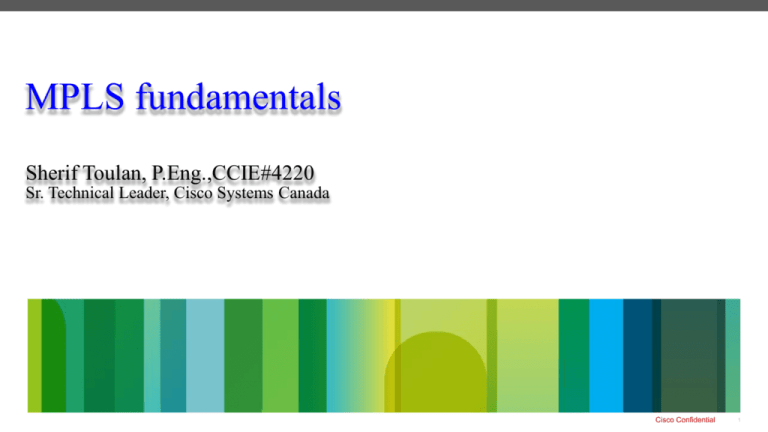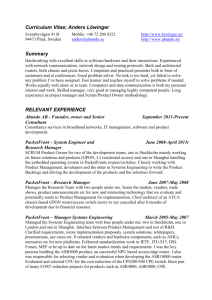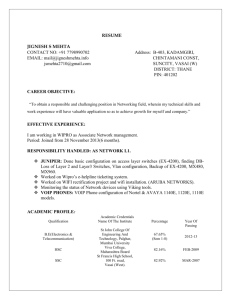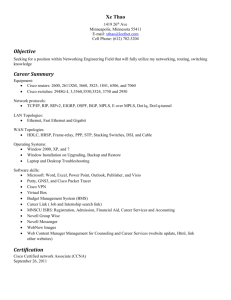
MPLS fundamentals
Sherif Toulan, P.Eng.,CCIE#4220
Sr. Technical Leader, Cisco Systems Canada
Cisco Confidential
1
Agenda
Topics
1. MPLS Technology Basics
2. MPLS Traffic Engineering (TE)
3. MPLS Layer-2 Virtual Private Networks (L2 VPN)
4. MPLS Layer-3 Virtual Private Networks (L3 VPN)
Summary
Cisco Systems
2
© 2015 Cisco Systems. All rights reserved.
MPLS Technology Basics
Cisco Confidential
3
Agenda
Evolution of MPLS
MPLS Reference Architecture
MPLS forwarding
Summary
Cisco Systems
4
© 2015 Cisco Systems. All rights reserved.
Evolution of MPLS
Technology Evolution and Main Growth Areas
•
Evolved in 1996 to full IETF standard, covering over 130 RFCs
•
Key application initially were Layer-3 VPNs, followed by Traffic
Engineering (TE), and Layer-2 VPNs
Optimize MPLS for
packet transport
Optimize MPLS for video
Complete base MPLS portfolio
Bring MPLS to Market
First L3VPNs
Deployed
Cisco ships
MPLS
1997 1998
Cisco Systems
Large Scale
L3VPN
Deployments
First MPLS TE
Deployments
1999
2000
Large Scale
L2VPN
Deployments
First L2VPN
Deployments
2001
2002
2003 2004
First MPLS
Transport
Profile
Deployments
Large Scale
MPLS TE
Deployments
2005
2006
2007 2008
2009
2010 2011
2012
2013
2014
© 2015 Cisco Systems. All rights reserved.
What Is MPLS?
• It’s all about labels …
• Use the best of both worlds
– Layer-2 (ATM/FR): efficient forwarding and
Multi
traffic engineering
– Layer-3 (IP): flexible and scalable
• MPLS forwarding plane
– Use of labels for forwarding Layer-2/3 data traffic
– Labeled packets are being switched instead
Protocol
Have:IPv4, IPv6, Ethernet, ATM, FR.
Could do IPX, AppleTalk, DECnet, etc etc.
Label
Uses Labels to tell a node what to do with a
packet; separates forwarding (hop by hop
behavior) from routing (control plane)
Switching
Routing == IPv4 or IPv6 lookup.
Then forwarding is based on label Switching.
of routed
• Leverage layer-2 forwarding efficiency
• MPLS control/signaling plane
– Use of existing IP control protocols
Multi-Protocol: The ability to carry any payload.
extensions + new protocols
to exchange label information
• Leverage layer-3 control protocol flexibility and scalability
Cisco Systems
6
© 2015 Cisco Systems. All rights reserved.
MPLS Reference Architecture
Different Type of Nodes & their Roles in a MPLS Network
• P (Provider) router
– Label switching router (LSR)
– Switches MPLS-labeled packets
• PE (Provider Edge) router
MPLS enabled Domain
PE
CE
P
P
PE
CE
– Label Edge router (LER)
– Imposes and removes MPLS labels
• CE (Customer Edge) router
CE
CE
– Connects customer network to MPLS
network, no labels to be sent to CE
nodes
Cisco Systems
PE
P MPLS core P
PE
Label switched traffic
7
© 2015 Cisco Systems. All rights reserved.
Basic MPLS Forwarding Operations
How Labels Are Being Used to Establish End-to-end Connectivity
•
Label imposition (Push)
MPLS enabled Domain
–
By ingress PE router; classify and
label packets
– Based on Forwarding Equivalence
Class (FEC)
•
Label swapping
–
•
By P router; forward packets using
labels; indicates service class &
destination
Label Imposition (Push)
CE
PE
Label Swap
P
P
L2
L1
L3
Label Disposition
(PoP)
PE
CE
MPLS core
CE
CE
Label disposition (Pop)
–
Label Swap
PE
P
P
PE
By egress PE router; remove label and
forward original packet to destination
CE
“FEC = Set of all packets that are going to be forwarded in exactly the same way”
Cisco Systems
8
© 2015 Cisco Systems. All rights reserved.
MPLS Labels
Label Definition and Encapsulation
•
Labels used for making forwarding
decision
•
Multiple labels (4 bytes) can be used for
MPLS packet encapsulation
•
Outer label always used for switching
MPLS packets in network
•
Inner labels usually used for services
(e.g. Layer 2/Layer 3 VPN)
MPLS Label Entry (4 bytes)
Label = 20 bits
EXP S
TTL
EXP = Experimental Bits for QoS : 3 Bits; S = Bottom of Stack; TTL = Time to Live
Layer 2 MAC Header
MPLS Label
4 bytes
Layer 3
Packet
MPLS Label Stack (1 label)
Cisco Systems
9
© 2015 Cisco Systems. All rights reserved.
MPLS Path (LSP) Setup
Traffic Forwarding
•
Label Switched Path (LSP) signaling
•
Exchange of labels
•
Either Label Distribution Protocol (LDP*) or RSVP
for TE (traffic engineering)
Leverages IP routing Forwarding Information Base
(FIB) table
Label bindings to IP addresses
Downstream MPLS node advertises what label to
use to send traffic to node
Forwarding
IP
MPLS
Destination address based
Label based
Forwarding table learned
from control plane
Forwarding table learned
from control plane
TTL support
TTL support
OSPF, IS-IS, BGP
Packet
Encapsulation
IP Header
One or more MPLS
labels
QoS
8 bit TOS field in IP header
3 bit Traffic Class field in
label
OAM
IP ping, traceroute
MPLS OAM
MPLS forwarding
MPLS Forwarding table
Cisco Systems
OSPF, IS-IS, BGP
Control Plane
* Label Distribution Protocol “LDP signaling
assumed for next the examples”
10
LDP, RSVP
© 2015 Cisco Systems. All rights reserved.
MPLS Path (LSP) Setup
Signaling Options
LDP
•
Label Distribution Protocol (LDP)
signaling
Forwarding path
LSP
– Leverages existing routing
•
Forwarding
Calculation
Can use both protocols simultaneously
– They work differently, they solve different
problems
– Dual-protocol deployments are very common
Packet Encapsulation
Based on IP routing database
RSVP
TE Tunnel
Primary and, optionally, backup
Based on TE topology database
Shortest-Path based
Shortest-path and/or other constraints
(CSPF calculation)
Single label
One or two labels
Initiated by head-end node towards
tail-end node
By each node independently
Signaling
Uses existing routing
protocols/information
Uses routing protocol
extensions/information
Supports bandwidth reservation
Supports link/node protection
Cisco Systems
11
Cont.
© 2015 Cisco Systems. All rights reserved.
IP Packet Forwarding Example
Basic IP Packet Forwarding
•
IP routing information exchanged
between nodes
– Via IGP (e.g., OSFP, IS-IS)
•
Packets being forwarded based on
destination IP address
IP Forwarding
Table
IP Forwarding
Table
Address
I/F
Address
I/F
128.89
1
128.89
0
171.69
1
171.69
1
…
IP Forwarding
Table
Address I/F
128.89
0
171.69
1
…
…
– Lookup in routing table
128.89.25.4
1
0
128.89.25.4 Data
0
128.89.25.4 Data
1
1
128.89.25.4 Data
128.89.25.4 Data
171.69.11.1
Cisco Systems
12
© 2015 Cisco Systems. All rights reserved.
MPLS Path (LSP) Setup with LDP enabled
Step 1: IP Routing (IGP) Convergence
•
•
Enable IGP Routing (OSPF or
ISIS) & MPLS LDP on all core
links, i.e. PE-P & P-P links
Exchange of IP routes in core via:
MPLS Forwarding Table MPLS Forwarding Table MPLS Forwarding Table
In
Address
Label Prefix
Out Out
I’face Label
In
Address
Label Prefix
Out Out
I’face Label
128.89
1
128.89
0
171.69
1
171.69
1
…
…
…
…
In
Address
Label Prefix
128.89
0
…
…
– OSPF, IS-IS….,etc.
•
0 128.89
Establish IP reachability
0
1
1
You Can Reach 128.89 and
171.69 Thru Me
Routing Updates (OSPF,
ISIS, …)
Cisco Systems
Out Out
I’face Label
13
You Can Reach 128.89 Thru Me
You Can Reach 171.69 Thru Me
171.69
© 2015 Cisco Systems. All rights reserved.
MPLS Path (LSP) Setup with LDP enabled
Step 2: Assignment of MPLS Labels
•
•
•
Local label mapping are sent to
connected nodes
Receiving nodes update MPLS
forwarding table
MPLS Forwarding Table MPLS Forwarding Table MPLS Forwarding Table
In Address Out Out
In Address Out Out
In Address ) Out Out
Label Prefix I’faceLabel
128.89
1
20
Label Prefix I’faceLabel Label Prefix I’faceLabel
20 128.89
0
30
30
128.89
0
-
-
171.69
1
21
21
171.69
1
36
…
…
…
…
…
…
…
…
…
…
…
0 128.89
LDP label advertisement
0
1
Use Label 20 for 128.89 and
Use Label 21 for 171.69
Label Distribution
Protocol (LDP)
Cisco Systems
…
14
Use Label 30 for 128.89
11
Use Label 36 for 171.69
171.69
© 2015 Cisco Systems. All rights reserved.
MPLS Traffic Forwarding with LDP
Step 3: Hop-by-hop Traffic Forwarding Using Labels
• Ingress PE node adds label to
packet (push)
– Via MPLS forwarding table
• Downstream node use label
for forwarding decision
(swap)
– Outgoing interface
– Out MPLS label
MPLS Forwarding Table MPLS Forwarding Table MPLS Forwarding Table
In Address Out Out
Label Prefix I’faceLabel
128.89
1
20
-
171.69
1
21
21
171.69
1
36
…
…
…
…
…
…
…
…
…
…
…
…
0 128.89
0
1
128.89.25.4 Data
1
128.89.25.4 Data
• Egress PE removes label and
forwards original packet (pop)
Cisco Systems
In Address Out Out
In Address Out Out
Label Prefix I’faceLabel Label Prefix I’faceLabel
20 128.89
0
30
30
128.89
0
-
Forwarding based on
Label
15
30 128.89.25.4 Data
20 128.89.25.4 Data
171.69
© 2015 Cisco Systems. All rights reserved.
MPLS Traffic Forwarding with LDP
Summary
1.
MPLS technology is widely deployed in Service Provider core networks, MPLS
increases the performance by doing forwarding based on labels
2.
The MPLS enabled routers (LSRs, LERs) use Label Distribution Protocol (LDP) to
assign & distributes labels.
3.
The MPLS enabled routers advertise their labels to other MPLS enabled routers, the
labels advertise reachability across MPLS network
4.
Data packets are forwarded using MPLS labels hence increasing speed &
performance in the Service Provider network
5.
MPLS label is 4 bytes!
Cisco Systems
16
© 2015 Cisco Systems. All rights reserved.
MPLS Traffic Engineering
Cisco Confidential
17
Agenda
• MPLS Traffic Engineering (TE) motivation
• MPLS TE Path Selection - Constraint-Based Shortest Path First (CSPF)
• MPLS TE signaling – LSP Setup – Resource Reservation Protocol (RSVP)
• Summary
Cisco Systems
© 2015 Cisco Systems. All rights reserved.
Link Utilization problem with IGP (OSPF or ISIS)
PE3
PE1
P2
40M
P1
Cost= 20
Cost= 20
DS3
DS3
PE2
40M
P3
OC3
Cost=10
P4
MPLS core
Cost=20
DS3
DS3
Cost=20
PE4
P5
IP (Mostly) Uses Destination-Based Least-Cost Routing
Flows from PE1, PE2 Merge at P1 and Become Indistinguishable
Upper path is overutilized!!
Alternate Path Under-Utilized!!
IGP = Interior Gateway Protocol (OSPF or ISIS)
Cisco Systems
© 2015 Cisco Systems. All rights reserved.
What MPLS-TE Addresses?
• P1 is the HEADEND & sees all links
• P1 computes paths on properties other than just shortest cost
• No oversubscription!
Node
Next-Hop
PE3
Tunnel0
PE4
Tunnel1
• Tunnel 0, Tunnel 1 are multi-hop tunnels
P2
40Mb
Tunnel 0
P1
OC3
PE3
P3
OC3
DS3
PE4
Tunnel 1
Tunnel 1
DS3
Tunnel 1
P4
Cisco Systems
Tunnel 0
DS3
40Mb
MPLS core
DS3
OC3
P5
© 2015 Cisco Systems. All rights reserved.
TE Terminology
• Constraint-Based Shortest Path First (CSPF) only run by Headend
– MPLS-TE uses CSPF to create a shortest path based on a series of constraints:
Resource Availability
User constraints ( tunnel priority,link attributes,metric,….etc.)
• Tunnels are UNI-DIRECTIONAL!
HEADEND
Upstream
Cisco Systems
MIDPOINT
Tunnel Direction
TAILEND
Downstream
© 2015 Cisco Systems. All rights reserved.
TE Fundamentals – “Building Blocks”
Step 2:
CSPF does Path Calculation on headend only –
uses IGP advertisements to compute
“constrained” paths
MPLS core
Tunnel Headend
node
Tail
Step 1:
Information Distribution IGP (OSPF or ISIS)
extensions used to flood
bandwidth information
between routers
Cisco Systems
Midpoint
Step 3:
Path SetupRSVP/TE used to distribute
labels, provide LAC, failure
notification, etc.
© 2015 Cisco Systems. All rights reserved.
Path Calculation “Constraint-Based Shortest Path First (CSPF)”
Find shortest
path to R8
with 8Mbps
R1
(Headend)
MPLS
15
10
3
5
10
R8
(Tailend)
8
10
10
• Additional link characteristics advertised by OSPF, ISIS TE
extensions
Interface address
Physical bandwidth
Maximum reservable bandwidth
Administrative group (attribute flags)
• IS-IS or OSPF flood link information
TE
Topology
database
• TE nodes build a topology database
• CSPF uses topology database to find best path for TE
• User Constraints and topology database used by CSPF as
input to path computation
n Link with insufficient bandwidth
n Link with sufficient bandwidth
Cisco Systems
• Tunnel can be signaled via RSVP once a path is found
© 2015 Cisco Systems. All rights reserved.
TE Path Setup using Resource Reservation Protocol (RSVP)
• Tunnel signaled with TE extensions to RSVP
• 4 main RSVP messages for TE
RSVP PATH message
RSVP RESV message
RSVP error message (PATHERR,RESVERR)
RSVP tear messages (PATHTEAT,RESVTEAR)
• Forwarding Table is populated using RSVP labels
allocated by RESV messages
Head end
IP/MPLS
Tail end
RSVP Label=16
RESV
Mid point
PATH
TE LSP
Cisco Systems
© 2015 Cisco Systems. All rights reserved.
How to map Customer Traffic into TE tunnel?
• Multiple traffic selection options:
Head end
Customer
Traffic
IP/MPLS
1.
Static routes
2.
Policy Based Routing
• Traffic enters tunnel at head end
TE LSP
Cisco Systems
© 2015 Cisco Systems. All rights reserved.
MPLS Traffic Engineering
Summary
1.
Traffic Engineering (TE) tunnels are used to manipulate the traffic across the Service provider core networks
2.
Traffic Engineering (TE) tunnels provide efficient utilization of links based on available bandwidth & defined
user constraints.
3.
Traffic Engineering (TE) tunnels use CSPF to establish the path & RSVP for signaling the TE tunnels
4.
Customer traffic can be mapped to TE tunnels to follow a specific path across the core network & as defined
in Service Level Agreements between Service Provider & Customer.
Cisco Systems
© 2015 Cisco Systems. All rights reserved.
MPLS Layer-2 Virtual Private Network
(L2 VPN)
Cisco Confidential
27
Agenda
• Layer-2 Virtual Private Network (VPN) Technology Options
• Virtual Private Wire Service (VPWS) overview
• Summary
Cisco Systems
© 2015 Cisco Systems. All rights reserved.
Layer 2 VPN (L2 VPN) Services to Customers
Service to Customers
• Layer-2 VPN
Layer-3 VPNs
Point to Point services or Virtual Private Wire
Services (VPWS) over MPLS
Service Provider sells the L2 VPN services to the
end Customers (banks, dealers,….etc.)
Cisco Systems
Layer-2 VPNs
Transport in the core network
29
MPLS (LDP/RSVP-TE)
MPLS Forwarding
© 2015 Cisco Systems. All rights reserved.
Layer-2 Virtual Private Networks (L2 VPN)
Technology Options- MPLS core
Virtual Private Wire Service (VPWS)
– MPLS is required in the core
– Point-to-point
– Referred to as Pseudowires (PWs)
• Virtual Private LAN Service (VPLS)
– Multipoint relies on flooding
– MPLS is required in the core
MPLS Layer-2 VPNs
Point-to-Point
Layer-2 VPNs (VPWS)
with MPLS core
Multipoint
Layer-2 VPNs (MPLS core)
xEVPN
• xEVPN
– Multipoint with optimized routes learning
– Optimized for load balancing, redundancy & scale
– MPLS is required in the core
VPLS
PBB-EVPN
EVPN
Cisco Systems
30
© 2015 Cisco Systems. All rights reserved.
Layer-2 VPN Enabler
The Pseudo wire
Provider
Edge (PE)
• L2 VPNs are built with Pseudo wire (PW)
technology over MPLS networks
Provider
Edge (PE)
• PWs provide a transport to multiple types
of network services over a Packet
Switched Network (PSN)
Packet
Switched
Network
• PW technology provides Like-to-Like
transport and also Interworking (IW)
• No routing is involved with Customers
– Customers can run their own
routing,QoS,security,….etc.
Pseudo wire
FR
ATM
TDM
PPP/HDLC
Ethernet
Cisco Systems
© 2015 Cisco Systems. All rights reserved.
Virtual Private Wire Service (VPWS)
Overview
Cisco Confidential
32
Pseudo wire (PW) Reference Model
• An Attachment Circuit (AC) is the physical or virtual circuit attaching a CE to a PE
• Customer Edge (CE) equipment perceives a PW as an unshared link or circuit
• Provides a point2point service
• Discovery: Label Distribution Protocol (LDP)
Emulated Layer-2 Service
• Signaling: Label Distribution Protocol (LDP)
• Emulated services can be:
– Virtual Local Area Network (VLAN)
– ATM
– Frame Relay
– HDLC/PPP
Pseudo wire (PW)
PSN
Tunnel
Native
Service
CE1
AC (Ethernet)
AC (ATM)
PE1
PW1
Native
Service
PE2
AC (Ethernet)
PW2
CE3
CE2
AC (ATM)
CE4
Ref: RFC 3985 Pseudo Wire Emulation Edge-to-Edge (PWE3) Architecture
Cisco Systems
© 2015 Cisco Systems. All rights reserved.
VPWS data forwarding Processing
Tunnel label
swapping through
MPLS cloud
VC and Tunnel
label imposition
Push tunnel label
Push data traffic label
Data traffic
VC label
disposition
Pop
Swap
Tunnel Label= 34
Tunnel Label =45
VC Label= 28
VC Label= 28
VC Label= 28
Data traffic
Data traffic
Data traffic
PE1
P2
P1
CE-1
MPLS
Data traffic
PE2
CE-2
Data Traffic direction
Cisco Systems
© 2015 Cisco Systems. All rights reserved.
Summary
Cisco Systems
1.
Layer-2 VPN enables transport of any traffic over MPLS network by a Service Provider core network
2.
Layer-2 VPN is simple & Service Provider has no control or visibility in customer data
3.
Label Distribution Protocol (LDP) is used for signaling & discovery between Provider Edge (PE) nodes
4.
Typical applications of L2 VPN are layer-2 business VPN services & Data Center Interconnect
5.
Customer Layer 2 traffic can be mapped onto a Traffic Engineering (TE) tunnel inside the Service Provider
core network
35
© 2015 Cisco Systems. All rights reserved.
MPLS Layer-3 Virtual Private Network (L3
VPN)
Cisco Confidential
36
Agenda
Cisco Systems
•
MPLS Layer-3 VPN (L3 VPN) fundamentals
•
Summary
© 2015 Cisco Systems. All rights reserved.
Layer-3 VPN vs. Layer-2 VPN
Layer 3 VPN
•
Customer end points peer with providers’ routers at Layer 3, i.e. there is routing protocol between Customer & Service Provider
•
Provider network responsible for distributing routing information to VPN sites
•
Don’t have to manually fully mesh customer endpoints to support
any-to-any connectivity
Layer 2 VPNs
• Customer endpoints connected via Layer 2 such as Frame Relay, ATM, Ethernet,….etc. connection
• Provider network is not responsible for distributing site routers as routing relationship is between the customer endpoints
• Provider will need to manually fully mesh end points if any-to-any connectivity is required
Cisco Systems
© 2015 Cisco Systems. All rights reserved.
MPLS Layer-3 VPN Control Plane Basics
CE3
iBGP—VPNv4
Label Exchange
P1
VRF1
CE4
PE3 VRF1
P2
PE1
VRF2
LDP
LDP
LDP
VRF2
iBGP—VPNv4
iBGP—VPNv4
PE2
CE1
CE2
1. VPN service is enabled on PEs (VRFs are created and applied to VPN site interface)
2. VPN site’s CE1 connects to a VRF enabled interface on a PE1
3. VPN site routing by CE1 is distributed to MP-iBGP on PE1
4. PE1 allocates VPN label for each prefix, sets itself as a next hop and relays VPN site routes to PE3
5. PE3 distributes CE1’s routes to CE2 (Similar happens from CE2 side…)
Cisco Systems
© 2015 Cisco Systems. All rights reserved.
MPLS Layer-3 VPN Packet Forwarding
6
Lookup of VPN
label in VRF table
5
Pop MPLS
top label
Labeled
packet
forwarded
7
Bank of Amercia
Packet
forwarded as
IP packet
VPN label
IP packet
enters PE on
VRF interface
VPN label
IP packet
IP packet
Bank of Amercia
IP packet
VRF
interface
VRF
interface
PE
2
1
MPLS label
IP packet
CE
3
Lookup of destination IP address in VRF table
• VPN label pushed
• MPLS label pushed
CE
PE
P
P swaps
MPLS label
Site A
Cisco Systems
4
MPLS VPN Service Provider Network
Site B
© 2015 Cisco Systems. All rights reserved.
The Full MPLS integrated Network:
Layer-3 VPN, Layer-2 VPN, Traffic Engineering technologies
Traffic Engineering for
Bandwidth protection and
restoration
Layer 3 Routing protocols
available on PE-CE –
Static OSPF,BGP
CE
Internet
Layer 3 Routing
protocols available on
PE-CE – Static, RIPv2,
OSPF, EIGRP, eBGP
Internet
Gateway
PE
MPLS Backbone
CE
PE
CE
CE
Layer 2 Circuits available –
Ethernet, ATM, Frame
Relay, PPP, HDLC
Cisco Systems
Layer 2 Circuits available
Ethernet, ATM, Frame
Relay, PPP, HDLC
Legend
Layer 3 VPN
Layer 2 VPN
Traffic Engineering
© 2015 Cisco Systems. All rights reserved.
MPLS session
Key Takeaways
1.
MPLS networks consist of PE routers at ingress/egress and P routers in the core
2.
MPLS forwarding operations is based on MPLS labels, hence it speeds up the performance
3.
Label Distribution Protocol (LDP) is used for MPLS signaling
4.
Routing protocols (OSPF or ISIS ) enabled in the core network has to be working properly for proper MPLS
forwarding operation
5.
Traffic Engineering manipulates that path of traffic to better utilize bandwidth & meet Service Level
agreements between Service Provider & Customer
6.
RSVP is used for TE signaling
7.
Layer 3 VPN requires routing between Customer sites & Service Provider
8.
Layer 2 VPN does not require routing between Customer sites & Service Provider
9.
MPLS & its associated technologies are widely deployed across both Service Provider & Enterprise networks
Cisco Systems
42
© 2015 Cisco Systems. All rights reserved.
Thank you.
Acronyms
Acronym
Description
Acronym
Description
MPLS
Multi Protocol label switching
ISIS
Intermediate system to intermediate system
TE
Traffic Engineering
LSR
Label switch router
VPN
Virtual Private Network
ATM
Asynchronous transfer mode
LER
Label edge router
FR
Frame relay
CSPF
Constraint-based shortest path first
IP
Internet protocol
PBR
Policy based routing
FEC
Forwarding equivalence class
PW
Pseudowire
LDP
Label distribution protocol
VPLS
Virtual private LAN service
LSP
Label switched path
VPWS
Virtual private wire service
TOS
Type of service
EVPN
Ethernet Virtual Private Network
RSVP
Resource reservation protocol
PBB-EVPN
OAM
Operation, administration, maintenance
Provider backbone bridging Ethernet Virtual Private
Network
BGP
Border gateway protocol
PSN
Packet Switched network
VLAN
Virtual local area network
TTL
Time to live
HDLC
High-level data link control
QoS
Quality of service
PPP
Point-to-point protocol
IGP
Interior gateway protocol
IGP
Interior gateway protocol
OSPF
Open shortest path first
RIPv2
Routing information protocol version 2
MAC
Media Access Control
EIGRP
Enhanced Interior Gateway Routing Protocol
LAC
Link Admission Control
OAM
Operation, Administration & Maintenance
Cisco Systems
44
© 2015 Cisco Systems. All rights reserved.







